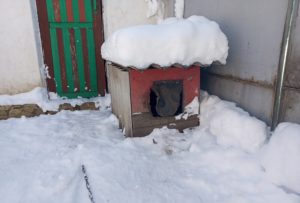
Why did I make heating in the dog house?advertisement
Before talking about the design of heating in my dog's booth, I will answer a question that some readers will probably have: “Why? She's a dog! Her thermoregulation is enough for her. Enough of a good booth for her ...!
The fact is that this dog came to me in August 2014, a month old puppy. In October, he fell ill - almost dropped his paws. I don’t remember what the sore was called, but I had to take care of him for a couple of weeks, like a loved one: injections, enemas, spoon-feeding ...
After he recovered (in November), the question of the place of his future life became acute. On the street in a booth or in a house. Although he became family during the treatment, he did not want to leave him in the house (after all, a watchman is needed). And to transfer to the booth, a 5-month-old puppy that has barely grown strong ... also somehow ... not humanly. Moreover, the first frosts began. And there's a whole winter ahead...
A compromise was found very quickly. I decided to create the most comfortable conditions for him in the booth.
The insulated booth at that time already existed. It remains only to do ... heating.
How to make heating in the booth.
Heating elements for heating the dog booth, I had to do it myself.
For this I needed:
- transformer 220 / 5V with a power of 250W;
- glass jar or bottle;
- nichrome spiral with a diameter of 0.3 mm
- clean, dry sand;
- a lid for a jar or a cork for a bottle;
- copper wires with a cross section of 2.5 mm2;
- terminal blocks for connecting wires.
The power supply of this entire heating system comes from a 250 W transformer, the voltage of the secondary winding is 5V.
I connected in parallel 3 pieces of nichrome wire, each 0.3 mm in diameter and about 25 cm long.
With the help of terminal blocks, I connected the wire to the copper wires.
I placed the wire inside the can so that it did not touch the walls of the can. Filled the jar with sand. He tapped the jar on the table to lightly compact the sand.
He led the copper wires through the lid and closed the jar with it. It is very convenient to use the lid for making wine. This heater is designed for a supply voltage of 5V, and the power dissipation is 35-40W.
At first I made one heater, but when serious frosts came, just in case, I installed another heater in the booth, but this time I used a bottle from Champagne.
Both heaters were securely fastened to the walls of the booth. The power wires are connected inside the metal-plastic tube. If you lay an open wire, the dog can gnaw it (it was already like that).
In general, this booth itself is very warm: multilayer walls with 5 cm foam between the outer and inner skin. The entrance to the booth is covered with a piece of rubber tape - so that the heat does not come out of the booth. This tape does not prevent the dog from darting back and forth. But it does keep warm. The tape does not completely cover the entrance - so that fresh air enters a little. Over time (as in the photo), the tape becomes unusable (for 3-4 years).
At the time of this writing, it's minus 20 outside. And my dog is hugging a bottle, burying his tail in a jar ... and enjoying life.
For more information about creating a booth and heating elements, you can watch these videos: